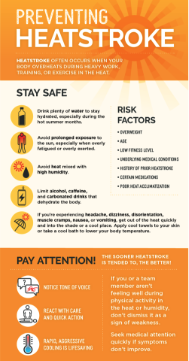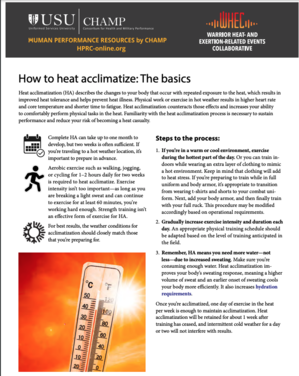Fact check! Test your knowledge of heat illness and ways to prevent it based on CHAMP’s video series on exertional heat illness.
Name 5 risk factors for heat illness.
Why are Service Members especially susceptible to exertional heat illness?
Service Members can be at risk for exertional heat illness for many reasons, including:
- Required protective clothing during training and while on duty
- Working conditions like naval ship boiler rooms and combat vehicles
- Field training in extreme heat without proper hydration
How is exertional heat illness mitigated?
Exertional heat illness is mitigated by being aware of risks, ensuring acclimatization and hydration, rapidly identifying heat illness, and seeking immediate treatment such as cold-water immersion for the affected individuals.
Why is exertional heat stroke so dangerous?
Exertional heat stroke can cause organ damage, which can be fatal.
List 5 signs and symptoms that characterize heat exhaustion.
- Tachycardia
- Orthostasis
- Diaphoresis
- Flushed skin
- Body temperature from 101-104℉ (38.3-40℃)
Name end-organ injuries caused by heat injury.
- Acute kidney injury
- Liver injury
- Rhabdomyolysis
Up to how long can full heat acclimatization take?
List 4 cooling methods used to treat heat illness.
- Arm immersion
- Cold-water shower
- Ice sheets
- “Ice Burrito” technique
List forms of follow-up care after exertional heat illness.
- Clinical lab analysis
- Medical observation
- Communication with patient
- Transfer to higher level of care
When can the affected Service Member return to active duty?
The affected Service Member can return to active duty after an established diagnosis, a return-to-normal state from an end-organ injury, and a period of recovery that allows for exercise and heat acclimatization.


